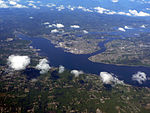Bremerton High School

Bremerton High School is four-year public secondary school in the port city of Bremerton, Washington, west across Puget Sound from Seattle, in the Bremerton School District. Between 1993 and 2007, Bremerton High School contained grades 10–12 for enrolled students, but starting in the 2008 school year, the school facilitates grades 9–12, where grade 9 was previously contained at Bremerton Junior High School. Several changes in the district's grade configuration have meant freshmen have been in and out of the building. In 2015, the school came to national attention following the suspension of football coach Joe Kennedy, who would pray at the 50-yard line of the field after varsity games. In 2022, the resulting lawsuit reached the Supreme Court, where it was decided in Kennedy v. Bremerton School District (2022) that Kennedy's First Amendment rights had been violated by the suspension.
Excerpt from the Wikipedia article Bremerton High School (License: CC BY-SA 3.0, Authors, Images).Bremerton High School
13th Street, Bremerton
Geographical coordinates (GPS) Address Phone number Website External links Nearby Places Show on map
Geographical coordinates (GPS)
| Latitude | Longitude |
|---|---|
| N 47.573 ° | E -122.639 ° |
Address
Bremerton High School
13th Street 1500
98337 Bremerton
Washington, United States
Open on Google Maps









